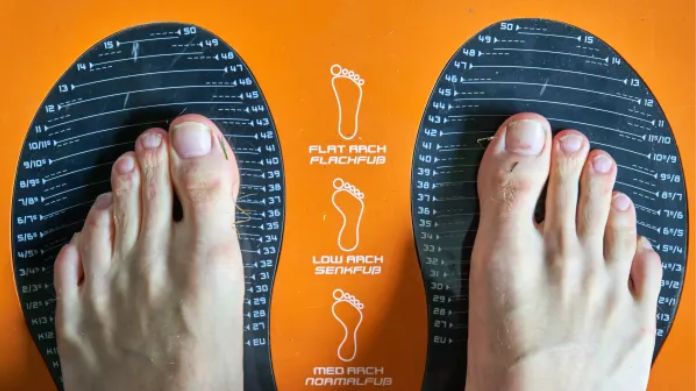Finding the perfect shoe size is essential for comfort and foot health. While shoe size is determined mainly by foot length and width, there is a correlation between shoe size and height for men. Taller individuals may often have larger feet, but this is not a strict rule, as foot size can vary widely among individuals of the same height.
Conversion charts serve as a helpful tool in determining the average shoe size for men based on height. These charts consider average foot measurements corresponding to different heights, providing a guideline for selecting the correct shoe size.
In this Height Comparison article, we will examine the average shoe size for men by height and provide conversion charts to assist individuals in finding their optimal shoe size. Understanding these correlations can make shopping for footwear more manageable and ensure a comfortable fit that promotes overall foot health.
What Determines a Man’s Foot Size?

Several factors, including genetics, age, weight, and overall body structure, determine a man’s foot size. Here are the key determinants of foot size:
Genetics: Like many physical traits, foot size is influenced by genetics. Children often inherit foot size characteristics from their parents, including their feet’ length, width, and arch type.
Age: Foot size can change over time, particularly during periods of growth such as childhood and youth. As a person grows, their feet typically grow as well. However, once growth stops, foot size tends to remain relatively stable unless influenced by other factors like weight gain or medical conditions.
Weight and Body Structure: Body weight distribution can affect foot size. People with higher body weight or a larger body frame may have larger feet to support their weight and maintain balance.
Health Conditions: Certain medical conditions or abnormalities can impact foot size. For example, conditions like flat feet, high arches, bunions, or arthritis can affect the shape and size of the feet.
Activity Level: The type and amount of physical activity a person engages in can also influence foot size. Athletes or individuals who commit to activities that stress the feet (such as running, dancing, or sports) may have more robust and potentially more significant feet due to increased muscle development.
Shoe Fit and Comfort: Wearing ill-fitting shoes over time can affect foot size perception. Tight or narrow shoes can compress the feet, leading to discomfort and potentially altering foot shape. It’s essential to wear properly fitting shoes that provide adequate support and space for the feet to maintain their natural size and shape.
While genetics play a substantial role in determining foot size, other factors such as age, weight, health needs, and lifestyle choices can also contribute to variations in foot size among individuals. Maintaining good foot health, wearing appropriate footwear, and seeking professional advice can help ensure foot comfort and support.
How to Know Your Right Shoe Size?
Knowing your correct shoe size is essential for ensuring comfort, proper fit, and avoiding foot problems. Here are some tips on how to determine your right shoe size:
Measure Your Feet:
- Place a bit of paper on the floor against a wall.
- Stand on the paper with your heel against the wall and your weight evenly dispersed on both feet.
- Mark the longest part of your foot (typically the tip of your big toe) on the paper.
- Repeat the process for your other foot, as feet can vary in size.
- Measure the distance between the wall and the marks for each foot in inches or centimeters.
Use a Shoe Size Chart:
- Convert your foot measurements to shoe sizes using a reliable shoe size chart.
- Remember that shoe size charts may vary slightly between different countries and brands.
Consider the Shape of Your Feet:
- Consider the width of your feet (narrow, medium, or broad) when selecting shoe sizes.
- Some brands offer different shoe widths, so check for a specific width.
Try on Shoes Later in the Day:
- Feet tends to swell throughout the day, so it’s best to try on shoes later when your feet are at their largest.
- This helps ensure that your shoes will remain comfortable throughout the day.
Wear Appropriate Socks:
- When trying on shoes, wear the socks you typically wear with that style.
- This will help you get a more accurate sense of fit and comfort.
Check the Fit:
- When trying on shoes, ensure there is about a thumb’s width of space between the end of your most extended toe and the front of the shoe.
- Walk around to check for any slipping, rubbing, or pinching.
- Make sure your feet feel comfortable and supported in the shoes.
Get Measured Regularly:
- Foot size can change due to age, weight gain or loss, and pregnancy.
- Have your feet measured every year or two to ensure you wear the correct size.
Remember, proper shoe fit is crucial for comfort, support, and maintaining the health of your feet. It’s always best to consult a podiatrist or foot specialist for personalized advice if you have any specific concerns or foot conditions.
Average Shoe Size for Men by Height

The average shoe size for men is often related to their height, although individual variations can occur due to factors such as foot shape and genetics. Here’s a general guide to the average shoe size for men based on their height:
| Height (feet & inches) | Height (centimeters) | Average Shoe Size (US) | Average Shoe Size (UK) | Average Shoe Size (EUR) |
|---|---|---|---|---|
| 5’4″ – 5’7″ | 162 – 170 cm | 7 – 9 | 6 – 8 | 39 – 42 |
| 5’8″ – 5’11” | 173 – 180 cm | 9.5 – 10.5 | 8.5 – 9.5 | 42 – 44 |
| 6’0″ – 6’2″ | 183 – 188 cm | 11 – 12 | 10 – 11 | 44 – 46 |
| 6’3″ – 6’5″ | 191 – 195 cm | 12.5 – 13.5 | 11.5 – 12.5 | 46 – 48 |
| 6’6″ and above | 198 cm and above | 14 and above | 13 and above | 48 and above |
This is a general guide, and individual shoe sizes may vary. Other factors that can influence shoe size include:
- Foot Width: Some men may have broader or narrower feet, affecting their shoe size.
- Brand Variations: Shoe sizes can vary slightly between different brands, so it’s always best to try on shoes before purchasing them.
- Foot Conditions: Specific foot conditions, such as bunions or hammertoes, can impact the fit and size of shoes.
- Personal Preference: Some men may prefer a tighter or looser fit, which can influence their shoe size.
When shopping for shoes, it’s essential to have your feet measured regularly, as foot size can change over time. It’s also a good idea to try shoes later in the day, as feet tend to swell slightly throughout the day. Always prioritize comfort and proper fit when selecting shoes to ensure the best possible support and minimize the risk of foot problems.
Final Note
The average shoe size for men is typically related to their height, with taller men often having larger feet. However, it’s important to remember that this is just a general guide, and individual shoe sizes can vary due to factors such as foot shape, width, and personal preference.
To ensure the best fit and comfort, it’s essential to have your feet measured regularly and to try on shoes before purchasing them. Finding the correct shoe size can help prevent foot problems and allow you to enjoy comfortable, well-fitting footwear.






